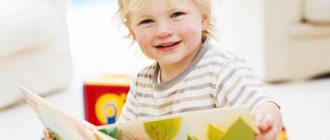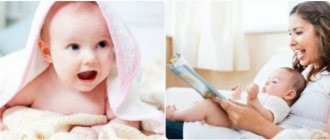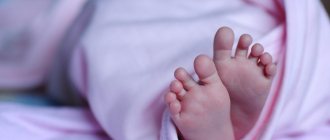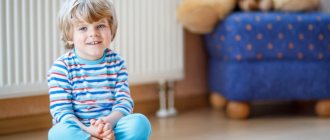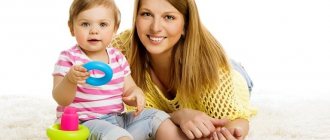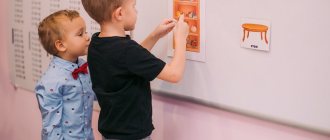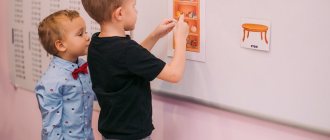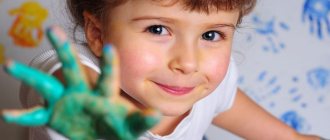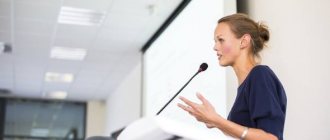A child’s speech at 2 years of age is actively formed against the background of the development of basic mental processes. Thinking helps him compare objects with each other and establish simple connections. Increasing the stability of attention allows you to listen to stories or reading by an adult. Memory and perception are increasingly improved and make it possible to master the norms of the native language with great success. Listening to short fairy tales and short stories is already meaningful; a child can repeat after an adult complex words, simple phrases, and retell a small part on his own.
In the second year of life, the baby is interested in everything that happens around him. He observes the objects of the surrounding world and masters the actions that can be performed with them. The main guides to the world of new information are adults from the immediate environment. But the baby can get help and new knowledge from them if he speaks. Communication with loved ones is the main incentive to master the native language between the ages of two and three years.
What should a two-year-old child be able to do according to the Munich Diagnostic System?
For parents who want to know the norms of psychomotor development of children under 3 years of age, it is useful to get acquainted with the Munich functional development diagnostic system. It was developed in 1997 and includes practical indicators of child development. According to this diagnosis, by the age of two years the baby should be able to:
- Walk on tiptoes without adult assistance;
- Stand on one leg for a short time;
- Jump;
- Go up and down stairs while holding the railing;
- Open doors;
- Unscrew and tighten the caps;
- String large beads onto a cord;
- Build towers from cubes;
- Throw and roll the ball;
- Name animals;
- Name parts of the body;
- Sort by color, size and shape;
- Correlate the image in the picture with the real object;
- Sing songs;
- Speak in short phrases;
- Play with peers;
A two-year-old child is already quite independent. The baby already has quite well developed coordination, he is constantly in motion. With the help of adults, a two-year-old can easily take care of himself: go to the potty, drink from a cup, eat with a spoon, wash and dry his hands, undress. Support your child's initiative and give him freedom - this way he will quickly learn to be independent.
2. Methodology for assessing the results of a diagnostic examination
To evaluate the results obtained in the process of diagnosing speech development, we use the following methodology: the child receives five tasks of the same type, compiled on the basis of program requirements in various areas of speech development. The results of completing each of the diagnostic tasks on the formation of vocabulary and grammatical structure of speech are assessed on a four-point scale:
- 3 points – high level (5 completed tasks out of 5);
- 2 points – average level (3-4 out of 5);
- 1 point – low level (1-2 out of 5);
- 0 points – not certified in this area (0 completed tasks out of 5).
The obtained data is entered into specially compiled diagnostic tables for the purpose of subsequent analysis.
This diagnostic examination is carried out at the beginning and at the end of the school year using the same didactic material to objectively assess the dynamics of children’s speech development.
When diagnosing speech sound culture, a scoring system is not used. In the diagnostic table for each child, marks are made for problematic (or unpronounceable) sounds.
During the diagnostic examination of coherent speech, a four-point scale similar to the one given above was used. At the same time, the same assessment criteria were used to assess the child’s ability to answer questions. Children’s ability to talk coherently (about an object, a picture, an event from personal experience) was assessed as follows:
- 3 points – high level (The child used both simple and complex sentences in the story. He is proactive and active in communication; a coherent story requires minimal help from an adult.);
- 2 points – (The child used mainly simple sentences or individual words in the story. The story is fragmentary, leading questions were required to support it. Communication is somewhat difficult due to the insufficient development of speech forms.);
- 1 point – (The child found it difficult to formulate sentences, helped himself with gestures and substitute words. There is no coherent retelling. He does not engage in communication on his own initiative.);
- 0 points – not certified in this area (refused to complete the task).
Development of fine motor skills at 2 years
It is known that improving fine motor skills is closely related to the intellectual and speech development of the baby. At the age of 2 years, children are especially interested in playing with small objects, rearranging them, sorting them, and stringing beads. Most often, it is at this age that the child’s leading hand is determined, but it is useful to do all the exercises with both hands (one at a time and simultaneously). You can get ideas for developing your baby's fine motor skills from this video:
Speech development classes at home
To develop a child’s speech, you need to conduct daily activities with him at home that contribute to this.
- Finger games.
Psychologists say that a child’s speech is on his fingers. That is, the development of fine motor skills has a beneficial effect on the development of the brain and, naturally, speech.
- Articulation gymnastics.
Only a well-developed articulatory apparatus will allow the child to clearly pronounce sounds.
- Hearing development.
- Memorizing poetry.
Finger games
Finger gymnastics is movement of the fingers and hands, which can be either active or passive. It includes finger play and massage. Finger gymnastics has the following advantages:
- Speech development
. The same area of the brain is responsible for the development of speech as the development of finger function. The more perfect the small movements, the more perfect the speech.
- Development of the sense of touch.
By working with his fingers, the baby learns to become aware of surfaces, thus developing tactile sensations.
- Development of motor skills.
The more often the baby works with his fingers, the better his coordination and fine movements.
- Memory development.
If finger games are performed with nursery rhymes, rhymes, and combined with a sense of rhythm, then active development of memory occurs.
We offer the following types of finger gymnastics:
- "Lock"
. The child clasps his hands into a “lock”, as if intertwining his fingers. An adult recites a simple rhyme and swings the “castle” to the side. “There is a lock on the door, who could open it? They knocked, here you need to knock with the child’s palms, without disengaging the fingers from each other, twisted, without disengaging the fingers, the child seemed to be twisting the brush, pulled, at this word the hands lightly stretch in different directions. And they opened it, the handles moved wide to the sides.
- Brush.
The child connects the pads of his fingers and swings the hand left and right with movements of the wrist and fingers. To the left - the fingertips are connected, to the right - they move apart. At the same time, the adult says the words: “I will paint the table and chair, Masha the cat, with a soft brush.”
- Knead the dough
. We knead the dough, we knead it, the child shows a movement that imitates the process of kneading the dough, we press the dough, we press it, we vigorously squeeze and unclench our fingers, we bake pies, we “make” a snowball with our hands.
Before finger gymnastics, it is better to get a massage. First, the child’s hands are warmed up, then each finger individually.
Articulation gymnastics
Articulatory gymnastics ensures the correct pronunciation of sounds. It allows you to strengthen the muscles of the speech apparatus, making them more mobile. Articulation gymnastics should be done while sitting at a table in front of a large mirror. The parent demonstrates each exercise himself, and the child’s task is to clearly repeat after him. Classes should be daily, lasting no more than 15 minutes. You can use the following exercises at home with your parents:
- "Kitty"
. The child opens his mouth wide, his tongue is wide and sluggish, imitating the movements of a cat as it laps up milk.
- "Shovel"
. The baby's mouth is wide open, a calm, soft tongue lies on the lower lip. After which the tongue hides in the “house”.
- "Proboscis".
The lips are pulled forward as long as possible, imitating the trunk of an elephant.
- "Hamster"
. The baby's mouth is closed, his cheeks are puffed out. This position is maintained for 5 seconds. After which the air is exhaled.
- "Frog"
. The child stretches his lips as much as possible in a smile, showing how a frog smiles.
Developing hearing
The formation of pronunciation depends on how well the child hears. The development of phonemic hearing will allow the baby to distinguish sounds and compare his speech with the speech of others. By the age of 3, children can already distinguish vowel sounds, voiced and hard consonants quite well. In order for their hearing to develop, we suggest performing tasks to differentiate the volume of a sound and recognize the object that makes this sound.
- We turn on the sounds of simple animals for the child, dogs, cats, hedgehogs, cows. We ask him to guess who “spoke.” Then we complicate the task, adding the sound of a hammer, washing machine, kettle, etc.
- We invite the child to find any sound in the words. We pronounce words in which the sound is at the beginning of the word, in the middle, at the end. The child’s task is to guess in which part of the word the given sound is located.
- We come up with words with a given sound.
- Stomp, clap if you hear the specified sound.
Reading, memorizing poetry
Thanks to reading and memorizing poems that are easy to pronounce, the child expands his horizons, his active vocabulary increases, his memory develops, and his general cultural level increases. In order for the activities to benefit the baby, you need to remember the simple rules that parents should follow:
- Give your child the opportunity to choose a book.
- Don't read “scary” books at night.
- Before you start reading, get to know the work yourself and evaluate whether your child will like it or not.
- Read with expression, not mechanically.
- Read regularly.
It is useful to look at books with bright pictures with children. Let the child name who is in the picture. For this purpose, it is better to use books about animals. Ask how the animal talks. Learning their “language” helps in mastering many sounds. Pay more attention to those animals that you can meet on the street. You can play at your home zoo by placing toys and saying the sounds that the animal makes.
Any activities with a child should be in the form of a game, at those moments when he feels good and is ready to cooperate with an adult. If you put pressure on children, they will withdraw, and there will definitely be no benefit from such activities. With systematic training with your child, success will be noticeable very quickly.
Development of perception in two-year-old children
If in the process of movement the baby explores the capabilities of his body, then with the help of perception (vision, hearing, smell, touch, taste) the child learns about the world around him.
- Vision . It is through vision that children, like adults, receive most information about the world. Children at the age of 2 already have good visual coordination and are able to follow a moving object with their eyes and distinguish between horizontal and vertical lines. However, they cannot yet simultaneously perceive the whole and the parts, so if the baby is in a crowd, it will be difficult for him to quickly detect his adult.
- Rumor . It is worth paying attention to the child’s auditory perception, since if there are hearing problems, the baby will most likely experience difficulties in speech development. At 2 years old, a child should be able to distinguish intonation well and understand simple requests.
- Taste and smell . For some reason, in our culture, practically no attention is paid to the role of these analyzers in a child’s exploration of the world. At the same time, in France, the development of taste buds is considered an important stage in the psycho-emotional development of a child.
- Touch . Tactile contact with significant adults is very important for the mental and physical health of the baby. It is thanks to him that children develop trust in the world, a sense of security and love. In early childhood, tactile perception of objects is on a par with visual perception. Babies acquire ideas about such concepts as cold/hot, hard/soft, smooth/rough thanks to tactile sensitivity.
For the development of a 2-year-old child, it is very important that the baby receives as many impressions as possible. It is desirable that information be obtained from different sources. In the nursery, for the harmonious development of children, a Montessori environment is organized, from which every child can learn exactly what he needs at the moment.
Improving speech development
It is not so difficult at this stage to help the child understand speech and use it himself. You just need to talk to him more often, and not distort words or lisp, but pronounce them correctly, clearly and distinctly, making clear, short sentences. It is very useful to verbally comment on them while doing everyday things: “I take a cup, pour water and drink.” In the same way, during a walk, you can name objects and give their characteristics, replenishing the baby’s vocabulary. Speech therapists recommend giving learning a playful form, for example, reciting rhythmic rhymes and performing parallel actions (“bears were riding,” “magpie-crow,” “ladushki”). Children often “swallow” sounds, which can and should be dealt with. For example, to teach a child to pronounce the sound “a” you need to ask him how a doll cries and show it by saying a drawn out “aaaaa”. Then you need to invite the baby to repeat this and insist until the baby does it. You can approach teaching the pronunciation of the sound “u” in the same way: while walking, point your baby to an airplane flying in the sky and indicate its buzz with a drawn-out sound “uuuuu”, asking the baby to repeat this sound. Usually children have no problems with this sound; they stretch out their lips with a tube and clearly pronounce “u”. When raising children, turning to Russian folklore in the form of ditties, nursery rhymes and jokes is of great benefit. Parents who regularly accompany joint actions with their child with humorous sayings much more quickly ensure that the child begins to speak better and more clearly in full-fledged phrases. To teach your baby to easily pronounce complex and long sentences, you need to develop his articulatory apparatus and teach him to breathe correctly. Tongue twisters are very useful for developing articulation. Repeating funny rhymes with counting rhymes by your child greatly helps the development of children's speech. Riddles are no less useful: first you need to make them for your child, and then work out the answer to them together. Over time, the baby will remember a number of riddles and even learn to come up with them himself, after which the parents and he will be able to tell each other their own riddles. Thanks to riddles, observation and imagination develop, and creative thinking progresses. Plus, asking riddles is a lot of fun. For example, when you are planning a game in a group, you can use a riddle to choose a leader - the child who guesses the riddle first becomes the leader.
Personal hygiene skills
A two-year-old child is already quite independent, and many parents strive to instill in their child the skills of self-care and personal hygiene. If you approach this issue wisely, then at 2 years old the child will be able to independently:
- Wash;
- To wash hands;
- Brush your teeth;
- Go potty.
Potty training is a challenge for many. Some try to force a child to sit on the potty, while others do not attach much importance to this skill. Scientists have found that children themselves begin to strive to go to the potty at the age of 1.5 - 2.5 years. Until this time, babies are just learning to control their intestines and bladder. Therefore, under no circumstances should you scold your child for “wet matters.” If the child himself wants to go to the potty, be sure to encourage this, praise any attempt by the child to control his body and be patient. Some people potty train quickly, while others constantly pee in their pants at 2 years old, but this is not a deviation from the norm. Be patient and your baby will definitely learn to go potty.
